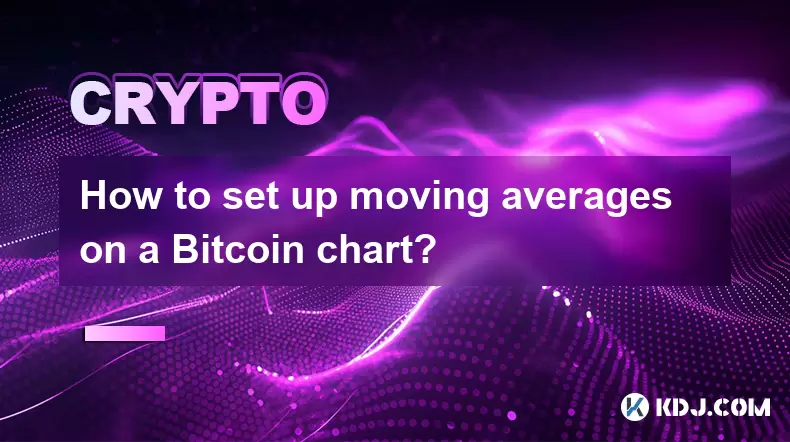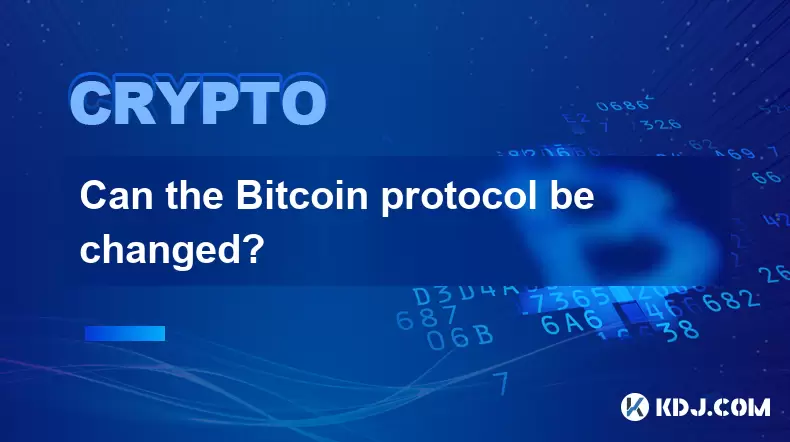-
 bitcoin
bitcoin $109667.069529 USD
-3.03% -
 ethereum
ethereum $3936.685804 USD
-4.07% -
 tether
tether $1.000493 USD
0.01% -
 xrp
xrp $2.771823 USD
-4.74% -
 bnb
bnb $957.805027 USD
-5.34% -
 solana
solana $196.735100 USD
-6.68% -
 usd-coin
usd-coin $0.999727 USD
-0.01% -
 dogecoin
dogecoin $0.227355 USD
-5.12% -
 tron
tron $0.335205 USD
-0.81% -
 cardano
cardano $0.779256 USD
-3.59% -
 ethena-usde
ethena-usde $0.999900 USD
-0.06% -
 hyperliquid
hyperliquid $42.492095 USD
-6.61% -
 chainlink
chainlink $20.501853 USD
-4.34% -
 avalanche
avalanche $28.952606 USD
-11.21% -
 stellar
stellar $0.356038 USD
-3.93%
How to set up moving averages on a Bitcoin chart?
Moving averages help Bitcoin traders identify trends by smoothing price data, with SMA and EMA commonly used to spot entry/exit points and confirm momentum through crossovers.
Jul 08, 2025 at 04:22 am

What are Moving Averages and Why Are They Important for Bitcoin Trading?
Moving Averages (MAs) are one of the most commonly used technical indicators in cryptocurrency trading. For Bitcoin traders, they help smooth out price data over a specified time period to identify trends more clearly. By filtering out short-term volatility, moving averages allow traders to spot potential entry or exit points.
There are several types of moving averages, including Simple Moving Average (SMA), Exponential Moving Average (EMA), and Weighted Moving Average (WMA). Each has its own calculation method and sensitivity to recent price changes. In Bitcoin trading, where price swings can be dramatic, understanding how to apply these tools correctly is crucial.
Selecting the Right Charting Platform
Before setting up moving averages, you must choose a reliable charting platform that supports technical analysis. Popular platforms include TradingView, Binance, CoinMarketCap, and Kraken. Most of these platforms offer built-in tools for adding moving averages directly onto your Bitcoin price chart.
To get started, log into your chosen platform and navigate to the Bitcoin price chart. Look for a section labeled “Indicators” or “Studies.” This is where you will find options to add various technical tools, including moving averages. Some platforms may require you to enable advanced charting features if they aren’t visible by default.
Adding a Simple Moving Average (SMA)
Once you’re on the Bitcoin chart, locate the indicator menu and search for “Simple Moving Average” or simply “SMA”. Click on it to add it to your chart. You’ll usually see customizable settings such as the period, which determines how many past data points the average will consider.
For example, selecting a 50-period SMA means the average is calculated using the last 50 candlesticks (or whatever timeframe you’re viewing). Common periods used by traders are 9, 20, 50, 100, and 200. After choosing your desired period, adjust the color and line style so it stands out against the price candles.
Some platforms also let you set the applied price, such as close, open, high, or low. Most traders use the closing price because it reflects the final sentiment of the market during each candlestick.
Configuring an Exponential Moving Average (EMA)
The Exponential Moving Average (EMA) gives more weight to recent prices, making it more responsive to new information compared to the SMA. To add an EMA, go back to the indicator menu and search for “Exponential Moving Average” or “EMA”.
Similar to the SMA, you’ll need to configure the period, line color, and applied price. Traders often combine EMAs with SMAs to confirm trends. For instance, a golden cross occurs when a short-term EMA crosses above a long-term SMA, signaling a potential bullish trend.
It’s important to note that shorter EMA periods react faster to price changes but can produce more false signals. Longer periods are smoother but lag behind actual price movements. Finding the right balance depends on your trading strategy and time horizon.
Customizing Multiple Moving Averages on One Chart
Many traders use multiple moving averages simultaneously to gain deeper insights. For example, the “Moving Average Ribbon” strategy involves plotting several MAs with different periods to visualize trend strength and momentum shifts.
To do this, add multiple SMAs or EMAs to your Bitcoin chart with varying periods. A common setup includes 8, 21, and 55 EMA or 9, 21, and 50 SMA. Each should have a distinct color and thickness for clarity. When these lines converge or diverge, it can indicate potential trend reversals or continuations.
Also, pay attention to how price interacts with these averages. If Bitcoin consistently trades above a key MA like the 200-day SMA, it may signal a long-term uptrend. Conversely, if it remains below, it could suggest a bearish phase.
Interpreting Crossovers and Divergences
One of the most popular strategies involving moving averages is the crossover method. This occurs when a short-term MA crosses above or below a longer-term MA. A bullish crossover happens when the short-term line moves above the long-term line, suggesting upward momentum. A bearish crossover occurs when the short-term line drops below, indicating possible downward movement.
Traders also watch for price crossovers with a single moving average. For example, if Bitcoin closes above its 50-day EMA, some traders interpret this as a buy signal. Conversely, a close below might be seen as a sell signal.
Divergence between price and moving averages can also provide valuable clues. If Bitcoin makes a new high but the moving average doesn’t confirm it, this could signal weakening momentum and an impending reversal.
Frequently Asked Questions
Q: Can I set up moving averages on mobile apps?Yes, most major trading platforms like Binance, Kraken, and TradingView offer mobile apps that support adding moving averages. The process is similar to desktop—navigate to the Bitcoin chart, open the indicators menu, and select the desired MA type and settings.
Q: Which moving average is best for intraday Bitcoin trading?For intraday trading, shorter-period EMAs like 9 or 21 are commonly used due to their responsiveness. Many day traders combine them with volume indicators to filter out false signals and improve accuracy.
Q: How do I reset or remove a moving average from my chart?Most platforms allow you to edit or delete indicators via the same indicator menu where you added them. Simply click on the gear icon next to the MA name and choose “Remove” or “Reset.”
Q: Do moving averages work well in sideways Bitcoin markets?In ranging or sideways markets, moving averages may generate misleading signals due to frequent crossovers without strong trends. It’s advisable to combine them with other tools like support/resistance levels or oscillators (e.g., RSI) for better decision-making.
Disclaimer:info@kdj.com
The information provided is not trading advice. kdj.com does not assume any responsibility for any investments made based on the information provided in this article. Cryptocurrencies are highly volatile and it is highly recommended that you invest with caution after thorough research!
If you believe that the content used on this website infringes your copyright, please contact us immediately (info@kdj.com) and we will delete it promptly.
- Bitwise, Hyperliquid ETF, and Perp DEXs: A New Era in Crypto Trading?
- 2025-09-26 12:25:15
- Ozak AI Price Prediction: Analyst Bull Case for $5 by 2026?
- 2025-09-26 12:25:15
- Bitcoin Price Wobbles: Support Failure and Trader Sentiment in the Mix
- 2025-09-26 12:45:16
- Dogecoin, Memecoins, and the Bull Cycle: Are We Still Barking Up the Right Tree?
- 2025-09-26 12:45:16
- Plasma Ignites DeFi: A New Dawn for Stablecoins and TVL?
- 2025-09-26 12:50:01
- Crypto Tax, Senate Showdown, and Trump Relief: What's the Deal?
- 2025-09-26 12:30:01
Related knowledge

Why is Bitcoin considered a revolutionary technology?
Aug 12,2025 at 08:29pm
Decentralization and the Elimination of Central AuthoritiesThe core innovation behind Bitcoin lies in its decentralized architecture, which fundamenta...

Why is Bitcoin considered a revolutionary technology?
Aug 10,2025 at 07:42pm
Decentralized Architecture and Trustless TransactionsBitcoin is considered revolutionary because it introduced a decentralized architecture that opera...

What are the key features of Bitcoin?
Aug 10,2025 at 02:50am
Decentralization and Peer-to-Peer NetworkOne of the most defining characteristics of Bitcoin is its decentralized nature. Unlike traditional financial...

Can the Bitcoin protocol be changed?
Aug 07,2025 at 01:16pm
Understanding the Bitcoin ProtocolThe Bitcoin protocol is the foundational set of rules that govern how the Bitcoin network operates. It defines every...

Can the Bitcoin protocol be changed?
Aug 11,2025 at 01:01am
Understanding the Bitcoin Protocol StructureThe Bitcoin protocol is the foundational set of rules that govern how the Bitcoin network operates. These ...

What happens to Bitcoin transactions once they are confirmed?
Aug 09,2025 at 05:22am
Understanding Bitcoin Transaction ConfirmationWhen a Bitcoin transaction is initiated, it is broadcast to the network and placed in a pool of unconfir...

Why is Bitcoin considered a revolutionary technology?
Aug 12,2025 at 08:29pm
Decentralization and the Elimination of Central AuthoritiesThe core innovation behind Bitcoin lies in its decentralized architecture, which fundamenta...

Why is Bitcoin considered a revolutionary technology?
Aug 10,2025 at 07:42pm
Decentralized Architecture and Trustless TransactionsBitcoin is considered revolutionary because it introduced a decentralized architecture that opera...

What are the key features of Bitcoin?
Aug 10,2025 at 02:50am
Decentralization and Peer-to-Peer NetworkOne of the most defining characteristics of Bitcoin is its decentralized nature. Unlike traditional financial...

Can the Bitcoin protocol be changed?
Aug 07,2025 at 01:16pm
Understanding the Bitcoin ProtocolThe Bitcoin protocol is the foundational set of rules that govern how the Bitcoin network operates. It defines every...

Can the Bitcoin protocol be changed?
Aug 11,2025 at 01:01am
Understanding the Bitcoin Protocol StructureThe Bitcoin protocol is the foundational set of rules that govern how the Bitcoin network operates. These ...

What happens to Bitcoin transactions once they are confirmed?
Aug 09,2025 at 05:22am
Understanding Bitcoin Transaction ConfirmationWhen a Bitcoin transaction is initiated, it is broadcast to the network and placed in a pool of unconfir...
See all articles










































































